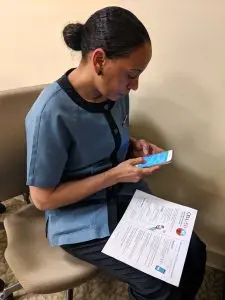If half of the adults in America picked up this article, they’d struggle to fully comprehend it. About one in seven couldn’t read it at all.
Now, imagine how tough it would be for these men and women to obtain a decent job.
A lack of transportation and affordable childcare are typically cited as the biggest barriers for low-income workers to get ahead. But there’s another fundamental factor that is easily overlooked: A huge part of the American labor force is illiterate.
“When you talk about adult literacy, it sounds like you’re referring to a few folks who fell through the cracks, but that’s not the case at all,” says Jessica Rothenberg-Aalami, the founder and CEO of Cell-Ed, a for-profit social enterprise that is making promising strides in combating the problem with a mobile learning platform targeted at low-skill workers. “It’s a hidden epidemic.”
Formally launched four years ago, Cell-Ed has had early success because it has taken great pains to design its product the right way: through rounds and rounds of testing and iterating, with the daily constraints of its cash- and time-strapped users always kept firmly in mind.
“This isn’t about the tech being glitzy,” says Kyle Athayde, state outreach coordinator at New York’s Office for New Americans, which has made Cell-Ed available to more than 1,500 immigrants over the past three years. “It’s about providing the things that people really need. They’ve made the technology human.”
Accessing Cell-Ed simply requires a phone that can text (although app- and internet-based versions are also available, as is a call-in-only option). Once plugged in, a learner is guided through a series of modules on a chosen topic, such as literacy or numeracy. Each module is made up of dozens of micro-lessons, which are delivered through a combination of audio, video, still images, and written content.
The need for both language and literacy
The vast majority of users, who are foreign-born, tap Cell-Ed to learn not only English as a second language but a full suite of basics: reading and writing (even in their native tongue), math, and soft skills. “Many of them have not gone past sixth grade in their home countries,” notes Laura Gonzalez-Murphy, director of immigration policy and research at New York’s Department of State.
Lessons last no longer than three minutes–perfect for someone to digest during a break at work or while waiting to pick up the kids from school. Meantime, Cell-Ed coaches are available around the clock to support a learner via messaging or a phone call.
“You see people burning through it because they love it,” Athayde says.
Luis Dominguez is among them. He arrived in the United States three years ago from Honduras and has been using Cell-Ed for about an hour a day over the past six months to learn to speak and write in English.
“I understand more,” says Dominguez, who lives on Long Island and is a painter for a construction company. “If I need something, I can ask for it.” He says that because his communication has improved, his boss increasingly trusts him to do a good job. Dominguez’s pay recently went up to $12 an hour from $9, and he’s being asked to work more–gains that he credits directly to Cell-Ed.
Cell-Ed, which last summer received a $1.5 million infusion from four impact-investing funds, charges nonprofits and government agencies an annual license fee of $50 per user (including the live coaching), with high-volume discounts that can cut the price in half. Corporate customers pay more–but still less than $10 a month. Individual learners pay nothing.
An expected explosion in growth
In all, Cell-Ed will serve about 30,000 people this year. By next year, however, it expects to have more than 1 million users–an explosion in growth that Rothenberg-Aalami attributes, in large part, to dozens of client organizations that are poised to start using the system at scale.
For the past few months, six Four Seasons hotels around the country have been piloting Cell-Ed with 100 Spanish-speaking housekeepers, who’ve been using the platform to learn English as well as a specially designed curriculum that reinforces the company’s culture, brand, and service standards.

Now, though, he is convinced that many of the Cell-Ed users have a real chance to become housekeeping coordinators or supervisors–jobs that would have been totally unthinkable before.
“It has enabled them to speak with guests comfortably,” Teague says. “There is a change in their confidence level. They have a different sense of energy.”
What’s happening with the Four Seasons staff is not unusual. A 2014 study issued by the Center for Global Development–one of several scholarly assessments that have validated Cell-Ed’s approach–found that it raised reading levels by the equivalent of two to four years in only four months. And those advances, in turn, were “correlated with an increase in students’ self-esteem by the end of the program.”
A window into poverty
In many ways, it’s since she was a little girl that Rothenberg-Aalami has been considering how those who are less fortunate can lift themselves up if they’re given the means.
In 1976, when she was four years old, Rothenberg-Aalami’s free-spirited parents sold their house in the heart of Silicon Valley and bought an old school bus, which was painted mint green and equipped with enough bunk beds for her and her four siblings. Their father was a Stanford-educated architect. But he had difficulty holding down a job, and as he bounced from place to place in search of his next work assignment over the next seven years, the bus rolled up and down the West Coast. It even made it as far as Alaska.

Their migratory existence also meant that Rothenberg-Aalami attended a dozen or so different schools as she grew up–and the inequality between them left a deep impression, as well. In a rich district, there would be state-of-the-art facilities, ski teams, arts programs, and more. In a poor district, the students didn’t even have textbooks.
“It always felt rigged by birthplace,” Rothenberg-Aalami says. “It always felt unfair.”
She went on to earn her doctorate in economic development at the University of Oregon, and during the next dozen years ran companies that undertook a string of technology-driven research and commercial projects focused on creating more opportunity for those around the globe who’d been left behind.
“That’s really been her life’s passion–helping those who are hardest to reach,” says Jeff Bruner, Rothenberg-Aalami’s twin brother, who after a career at Hewlett-Packard and Intel joined Cell-Ed as its technology director.
Despite the magnitude of the adult literacy crisis, most of those needing to make up lost ground are pushed toward traditional classroom settings–even though many of these people can’t possibly follow through because of cost or work schedules or other obstacles.
Beyond that, “there just aren’t a ton of products out there,” says Kelly Tyler, who runs the Office of Education and Literacy at the Los Angeles Public Library.
That’s why she is so thankful to have found Cell-Ed and another program called Learning Upgrade, which helps people absorb English and math through songs, video, games, and rewards. Both are finalists for the $7 million Adult Literacy XPrize, which has sought out solutions that are measurable, easy to use, and engaging.
When it comes to Cell-Ed, Sandra Portillo would certainly confirm that it’s engaging. The Los Angeles resident has been using Cell-Ed for about a month through the local branch of her library. Already, she’s hooked.
“It is an excellent tool for me,” says Portillo, a single mother of two who works as a nanny and hopes that her dedication will eventually lead to a better job. “If I learn a word a day, I will have 365 words.”
Her greatest challenge so far, she says, is in writing. But she seems determined to stick with it, to be “constant in my studying.” After all, even more than teaching Portillo to write all of those words, Cell-Ed is giving her a shot at writing something much bigger: her future.
Recognize your brand’s excellence by applying to this year’s Brands That Matter Awards before the early-rate deadline, May 3.
